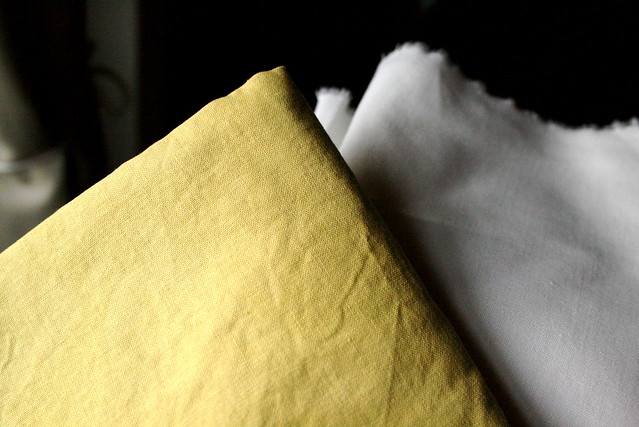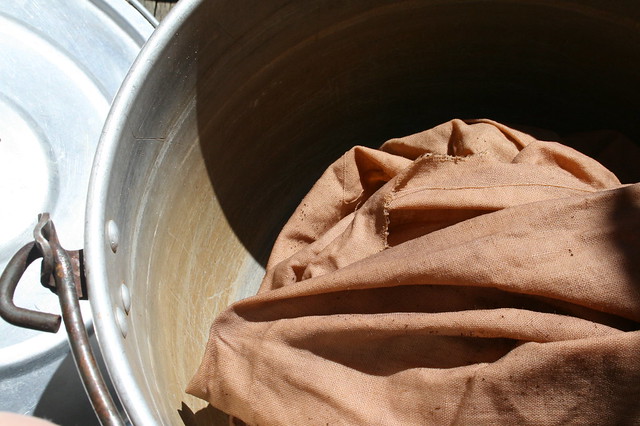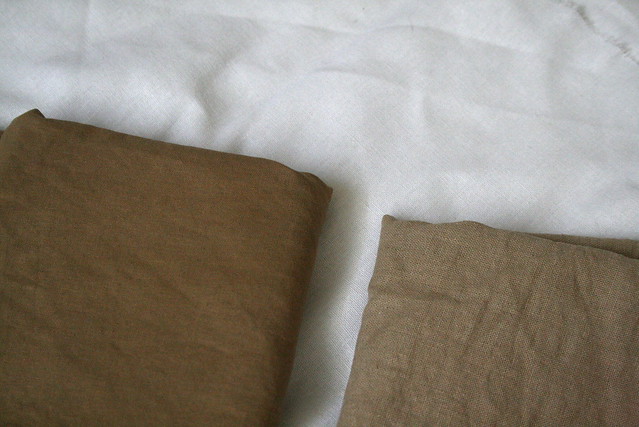 One of my first experiments with natural dyeing was done using golden rod up at my cottage this past summer. Let's just say that having access to a lake is a huge plus! When you get hot and sweaty from letting your plant matter and fabric boil on the stove, you can do the washing out part of the process in the lake while you go for a dip!
One of my first experiments with natural dyeing was done using golden rod up at my cottage this past summer. Let's just say that having access to a lake is a huge plus! When you get hot and sweaty from letting your plant matter and fabric boil on the stove, you can do the washing out part of the process in the lake while you go for a dip!
 The goldenrod produced a beautiful yellow.
The goldenrod produced a beautiful yellow.
 Sumac was my next solo experiment. It produced a lovely brown, but be warned: I think some sort of insect has a tendency to lay it's eggs in sumac. So you might find a whole ton of tiny larvae in your pot when boiling the plant. Kind of gross.
Sumac was my next solo experiment. It produced a lovely brown, but be warned: I think some sort of insect has a tendency to lay it's eggs in sumac. So you might find a whole ton of tiny larvae in your pot when boiling the plant. Kind of gross. 
 Our first group dyeing session occurred at Thea's house this past fall. I brought some walnuts I'd collected, and Thea supplied cochineal. She got the cochineal from Maiwa, a company located in BC that has a great selection of natural dyes and everything else you need for natural dyeing. And in case you didn't know, cochineal is an insect that lives on the prickly pear cactus that is native to Mexico and some other Central and South American countries. It's ground into a really fine powder for use in dyeing. While it may not be local, it is highly coveted because it produces absolutely gorgeous shades of pink.
Our first group dyeing session occurred at Thea's house this past fall. I brought some walnuts I'd collected, and Thea supplied cochineal. She got the cochineal from Maiwa, a company located in BC that has a great selection of natural dyes and everything else you need for natural dyeing. And in case you didn't know, cochineal is an insect that lives on the prickly pear cactus that is native to Mexico and some other Central and South American countries. It's ground into a really fine powder for use in dyeing. While it may not be local, it is highly coveted because it produces absolutely gorgeous shades of pink. 


 We had a lovely time, and our results were great! The pinks and browns that we produced ranged in tone quite a bit, depending on the material that was dyed (protein fibres such as wool pick up dye better than cellulose fibres such as cotton), and whether they were dyed in the first or second use of the dye bath. Using a mordant (like alum, iron, or tannic acid) can also alter and help set the colour.
We had a lovely time, and our results were great! The pinks and browns that we produced ranged in tone quite a bit, depending on the material that was dyed (protein fibres such as wool pick up dye better than cellulose fibres such as cotton), and whether they were dyed in the first or second use of the dye bath. Using a mordant (like alum, iron, or tannic acid) can also alter and help set the colour. 

Anna, a knit night regular, also decided to try her hand at dyeing. She used onion skins to dye some wool yarn, and got lovely results!
We are certainly looking forward to planning some more natural dye days as the weather gets warmer. There's an endless number of materials out in nature that can be used for dyeing, so there's no limit to our experimenting with them.
Photos courtesy of Kate, Hollie, and Anna

lovely post Kate! natural dyes are something i have not tried yet, but your cottage dyeing adventure intrigues me to try some this summer when i have a bit more time!
ReplyDeleteThese turned out beautifully. If only I lived closer! I would love to join the beehive!
ReplyDelete